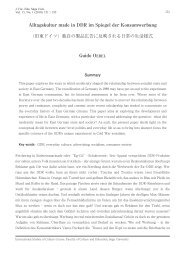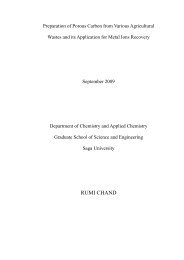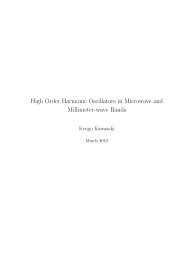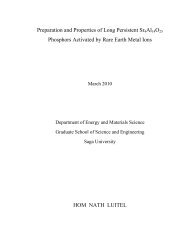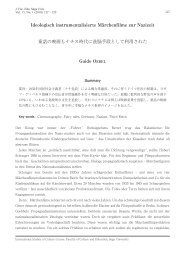ε (eV)
ε (eV)
ε (eV)
Create successful ePaper yourself
Turn your PDF publications into a flip-book with our unique Google optimized e-Paper software.
procedures is almost the same as its counterpart strain of Bacillus atrophaeus for-<br />
merly subtilis #AT CC 9372. Somedifferences have been observed recently among<br />
which the pigment which appears only to the last one [118]. Moreover, Bacillus<br />
atrophaeus is also known to produce a taxonomic confusion as a consequence of<br />
its reclassification. It is not the case of the strain of Bacillus subtilis #AT CC<br />
6633. Therefore, we choose to maintain the same sporulated form and its scien-<br />
tific nameastestingmicroorganismsthroughout the microbiological experimental<br />
procedure.<br />
2.3.2.2 Samples preparation<br />
Avolumeof100 µl of sterile water containing a spore population of N0 =10 6<br />
was aseptically spread (by dropping) on the surface of a glass slide (25 × 15 mm 2 )<br />
and allowed to dry overnight. In order to avoid the spore stacking, the initial<br />
volume of 100 µl wasdividedin5 aliquots of 20 µl, dropping them in 5 different<br />
points on the glass slide.<br />
For all the obtained samples, the covering degree of the glass slide surface<br />
was higher than 75% (i.e., α>0.75, whereα is the fraction of the wetted glass<br />
slide surface). Under these conditions the effective contaminated area of the glass<br />
slide is Aeff = αA > 281.25 mm 2 , A =375mm 2 being the surface of the glass<br />
slide. Consequently, the mean number of spores per effective contaminated area<br />
is n0 = N0/Aeff < 3.56 × 10 −3 µm −2 , which means that, on average, each spore<br />
33



